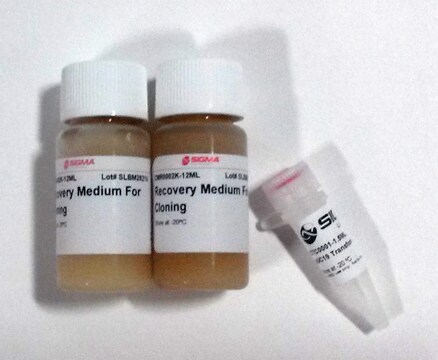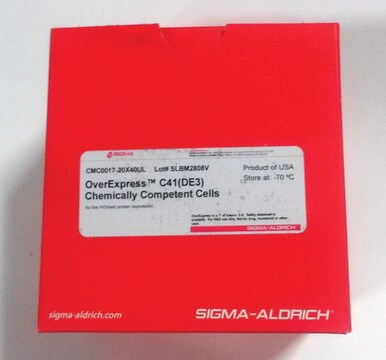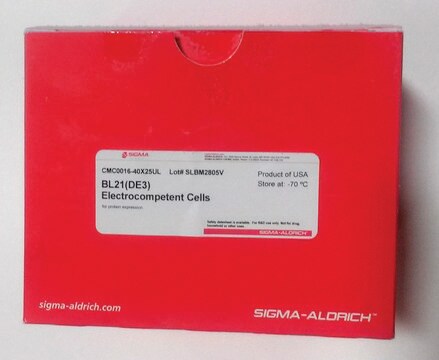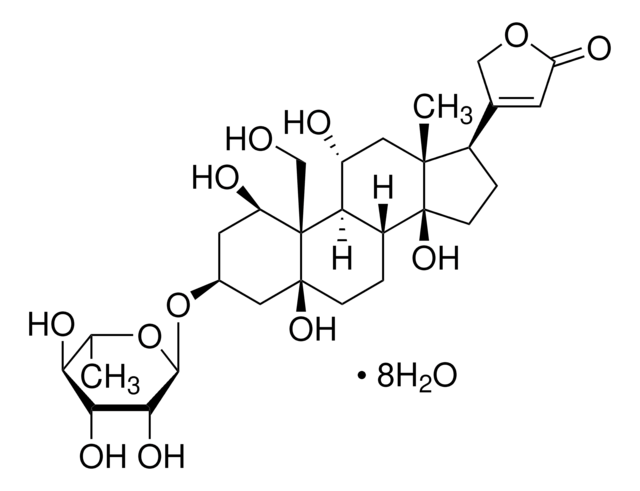71397
Rosetta 2(DE3) Competent Cells - Novagen
Escherichia coli, rod shaped
Sinonimo/i:
BL21 derivatives
About This Item
Prodotti consigliati
Nome del prodotto
Rosetta 2(DE3) Competent Cells - Novagen, Novagen′s Rosetta 2 host strains are BL21 derivatives designed to enhance the expression of eukaryotic proteins that contain codons rarely used in E. coli.
Origine biologica
Escherichia coli
Livello qualitativo
Produttore/marchio commerciale
Novagen®
Condizioni di stoccaggio
OK to freeze
Modalità di accrescimento
adherent or suspension
Morfologia
rod shaped
tecniche
microbiological culture: suitable
Trasformazione cellulare
transformation efficiency: >2×106 cfu/μg
Condizioni di spedizione
dry ice
Temperatura di conservazione
−70°C
Descrizione generale
This product contains genetically modified organisms (GMO). Within the EU GMOs are regulated by Directives 2001/18/EC and 2009/41/EC of the European Parliament and of the Council and their national implementation in the member States respectively. This legislation obliges us to request certain information about you and the establishment where the GMOs are being handled. Click here for Enduser Declaration (EUD) Form.
Rosetta 2 host strains are BL21 derivatives designed to enhance the expression of eukaryotic proteins that contain codons rarely used in E. coli. These strains supply tRNAs for 7 rare codones (AGA, AGG, AUA, CUA, GGA, CCC, and CGG) on a compatible chloramphenicol-resistant plasmid. The tRNA genes are driven by their native promoters.
DE3 indicates that the host is a lysogen of λDE3, and therefore carries a chromosomal copy of the T7 RNA polymerase gene under control of the lacUV5 promoter. Such strains are suitable for production of protein from target genes cloned in pET vectors by induction with IPTG.
Componenti
•2 × 2 ml or 4 × 2 mlSOC Medium
•10 µlTest Plasmid
Attenzione
Note legali
Codice della classe di stoccaggio
10-13 - German Storage Class 10 to 13
Classe di pericolosità dell'acqua (WGK)
WGK 2
Certificati d'analisi (COA)
Cerca il Certificati d'analisi (COA) digitando il numero di lotto/batch corrispondente. I numeri di lotto o di batch sono stampati sull'etichetta dei prodotti dopo la parola ‘Lotto’ o ‘Batch’.
Possiedi già questo prodotto?
I documenti relativi ai prodotti acquistati recentemente sono disponibili nell’Archivio dei documenti.
I clienti hanno visto anche
Il team dei nostri ricercatori vanta grande esperienza in tutte le aree della ricerca quali Life Science, scienza dei materiali, sintesi chimica, cromatografia, discipline analitiche, ecc..
Contatta l'Assistenza Tecnica.



